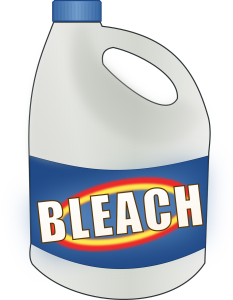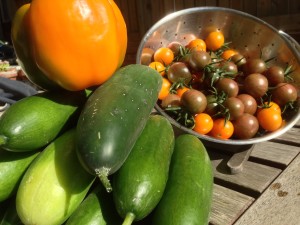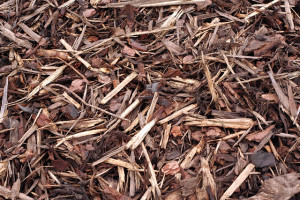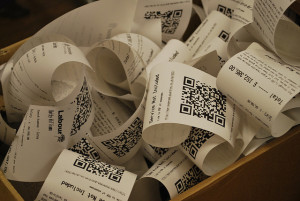It is spring and your world is awash with compostable materials from the kitchen and yard, but you’ve got no leaves to act as a carbon-rich material, so now what?

Shredded newspaper. Image courtesy of David Bleasdale, some rights reserved.
Newspaper is the typical answer, but is it safe?
This question comes up all the time, was recently raised on a NOFA-Mass email list I am a member of, and forced me to do some more digging in an effort to put the science in public view.
Some quick caveats: I am not a scientist, but I do like to read scientific literature and I can pronounce words that many third-graders cannot. Any errors of interpretation of the attributed studies are mine and mine alone. What I’m trying to provide here is scientifically accurate information, as found in studies, about the safety of using newspaper in compost, vermicompost and other uses like paper pots or mulch.
The research focused on published studies. Blog posts, media articles and un-cited statements were not considered source information. Ugly as they may be, full links are visible for ease of viewing and to put everything out in the open. I have no illusions that this is the final word on the issue.
The short version is this: Newspaper, like everything else in today’s environment, has compounds we would all prefer weren’t there but, in the end, these compounds are not likely to cause problems and/or are unavoidable due to the way we treat our planet. If they’re in newspaper, they’re in everything else, too.
Despite what some of these studies suggest, I still recommend that you do NOT use advertising inserts or glossy magazine pages, and that you NOT use junk mail, bank statements or items you’ve printed at work – you don’t know what the ink pigments are or whether the paper will leach dioxin.
The potential contaminants in newspaper examined include:
![]()
 Chlorine Bleach:
Chlorine Bleach:
This one has been thoroughly debunked. Newsprint is “bleached” with peroxide, an oxidizer, rather than chlorine bleach, which is more expensive. (Think about the price of copy paper vs. a big roll of newsprint for the kid to paint on.) Peroxide removes chlorine, among other things, and dissipates rapidly in the presence of either sunlight or heat.
Net Result: Bleach isn’t an issue in newspaper.
BPA: Newspaper is made from recycled paper, including the thermal, BPA-lined receipts that many stores offer. The BPA does not get washed out during the recycling process, so it remains in the newspaper you have. BPA also remains in recycled content facial tissues, napkins, etc. That amount is generally considered trivial. http://pubs.acs.org/doi/abs/10.1021/es300876n
However, BPA has a half-life of about three days when in soil. [http://www.ncbi.nlm.nih.gov/pubmed/12668032] Further, it “was concluded that if BPA reaches the soil compartment, it is not expected to be stable, mobile, or bioavailable” to plants or other organisms. [http://www.sciencedirect.com/science/article/pii/S0045653503001000]
Taking those findings to an extreme: even when plants were grown with biosolids containing high BPA levels, there was little uptake of BPA by the plants and invertebrates. [http://www.ncbi.nlm.nih.gov/pubmed/20821466]
(An aside: If you don’t want BPA in your napkins, toilet paper, etc., then please stop recycling those thermal receipts.)
Net Result: Since BPA has a half-life of three days in soil, it isn’t likely to be an issue, and it isn’t taken up by plants or organisms anyway.

Not really from these, but you get the idea.
VEGETABLE INKS: Newspaper inks are almost all vegetable-based these days. (Some, such as the Western, MA Gazette newspapers, are water-based, rather than oil-based.)
Lots of people take comfort saying that newspaper inks are vegetable-based, but it doesn’t really mean much since lots of materials get added to the oil as pigments. It is kind of like saying kitchen vinegar is water-based: Technically accurate, but that 5% concentration of acetic acid means you don’t want to use it like water.
Those who insist on no GMOs will want to avoid newspapers as the soy and other vegetable-based inks are almost certainly from GMO stock, but nobody has found (or at least published studies) suggesting that is a legitimate area of concern. Still, the vegetable oil is only the carrier, not the pigment.
Net Result: Inks are generally carried by vegetable oils, which are fine – it is the pigments that may be cause for concern.

By LordOider (Own work) [CC0], via Wikimedia Commons
A 1997 study of newspapers from around the country provides good reason to feel more comfortable using newspaper in compost and other situations. That study found arsenic and cadmium, as well as other potentially dangerous elements, at low or non-existent levels in most newspapers. https://app.box.com/shared/lsx0s8flsk
That 1997 study found, in part:
“All readings for chromium and selenium were within ranges normally associated with soils for the newspaper and glossy magazine samples. Arsenic and cadmium levels were very low or undetected in newsprint. Both minerals were found in slightly above concentrations, .01 to .07 cadmium and 1 to 50 for arsenic, in the kaolin coated [magazine] samples. The highest reading (sic) The highest reading for arsenic, 93.2 ppm, was found in the same glossy Sunday newspaper coupon insert. The highest readings for cadmium, 5 ppm, was from junk mail. It was a solicitation from The Nature Conservancy.”
The mix of newspapers included The Boston Globe, The New York Times and 50 or so others. While the study suggests glossy magazines and advertising inserts may be safe, I still prefer to avoid them as they may or may not use whatever inks are cheapest at that moment in time, as well as other materials. That study is also more than 15 years old, and practices have changed since then. One hopes practices have changed for the better, but if anybody knows of a more recent study of heavy metals in newspapers, please post something in the notes.
Cornell, a recognized leader in Ag sciences, says (in an un-cited article) that, “There has been concern about using colored paper or ink, which contains heavy metals. Evidence shows such low concentration of heavy metals – if any at all – that colored paper may be used without significant risk.” Without any citation for their statement, I am dubious, but since Cornell is highly regarded, I am including it here anyway. http://www.gardening.cornell.edu/factsheets/orgmatter/#paper
Cd is found in our air and water, largely due to human activities. (http://faculty.rmu.edu/~short/research/msc-environmental-chemistry-1995/heavy-metals/Nriagu-JO-and-Pacyna-JM-1988.pdf)
In soil, Cd commonly comes from those sources, sedimentary rocks and common soil amendments, such as phosphorus. (http://dge.stanford.edu/SCOPE/SCOPE_31/SCOPE_31_2.05_Chapter10_119-146.pdf) It is also worth noting that studies suggest municipal solid waste frequently contains elevated levels of Cd. (http://www.ncbi.nlm.nih.gov/pubmed/15022752)
While it seems clear that leafy greens take up more Cd than many other edible plants, studies seem a bit contradictory in their findings. Some say that “Cadmium is reasonably immobile in soils, and the available data suggest that the amounts removed by leaching are also small compared with amounts present.” (http://dge.stanford.edu/SCOPE/SCOPE_31/SCOPE_31_2.05_Chapter10_119-146.pdf)
Yet others say that “Concentrations of Cd in crops grown on soils elevated in Cd, either naturally or from anthropogenic sources, may accumulate substantially greater than 1.0 mg/kg. The amounts accumulated depend upon the level of Cd present in the root zone of the soil, the crop species, and the chemical properties of the soil,” such as pH, organic matter levels, and other properties.
Regardless, high levels of cadmium are not likely to be from newspaper.
Net Result: Cadmium may be present in newspaper due to ink pigments, but in very low quantities. There is good reason to believe Cd levels are lower than other ingredients used in your compost, and other inputs (such as phosphorous) to your soil.

Shredded bark. Image courtesy of www.crinklecrankle.com/
PIGMENTS – PCB 11: PCB 11 is long-lasting, bioaccumlative, persistent and a known toxin. PCB 11 is semi-volatile, easily airborne, and due to this is found everywhere, including at the poles.
The process of making long-lasting (durable and stable) pigments forms PCB 11. That is to say that no ink recipe says to “add PCB 11.” PCB 11 forms when certain other chemicals are mixed together. Though manufacturers could obviously change the formulation so PCB 11 isn’t formed, they argue that the result will be colors that fade.
This ability to become easily airborne and PCB 11’s bioavailability (plant uptake) have meant that PCB 11 is found, basically, in everything, including in trees in forests miles from any possible local contamination. The bark of those distant trees were found to have 0.5 ug/kg [http://link.springer.com/article/10.1007/s00128-014-1322-6#page-1], higher than the US federal limit of PCB 11 in (paper recycling facility) effluent, which is 0.00017 ug/kg.
Relative to using newspaper in compost, it is important to realize that studies have found that vegetation uptake of PCBs via roots is less than their uptake from the atmosphere, making the airborne PCB problem possibly greater than that in the soil. http://bit.ly/1KQZlXT and http://pubs.acs.org/doi/abs/10.1021/es960419i
Since all carbon sources take up PCB 11 from the air, and it is present everywhere, that really leaves us with no uncontaminated source of carbon-rich material.
Net Result: PCB 11 exists in newspaper, and just about everything else. The levels are likely to be the same or less in newspaper as they are in other carbon-rich sources such as trees, cardboard, etc.
So there you have it, a (hopefully) complete run down of potential contaminants in newspaper. If you’ve got science-based comments to add below, please do, and thanks for reading.


Fresh compost should not be used for starting sensitive seedlings such as tomatoes and peppers because they may succumb to damping-off disease.
Helpful post. Have you written something along these lines about cardboard? That would be useful, too.
Thank you, Laura. I haven’t written about cardboard because there seem to be so many variations of just corrugated cardboard, not to mention the boards used for paper towel rolls, cereal boxes and others.
Off the top of my head, corrugated cardboard might be all brown, colored, uncoated, slick-coated (I don’t know the technical term for that), and more. Then there’s the question of the glues used in producing the cardboards. Some glues are corn starch based, others may include other ingredients. Once you get to inks, it is open season as to what each manufacturer uses.
Unlike newspaper production, I’m not aware of any industry standards for any of these variations, which would make it difficult to say any single type is good while others are not. That said, while I prefer newspaper because it tears easily and degrades faster than cardboard, I personally wouldn’t hesitate to use -some- cardboard if no other carbon-rich sources were available. That seems unlikely though, as newspapers are still widely available.
I hope that helps.
Good post, keep
In response to your inquiry, we understand you would like to incorporate issues of the New York Times in your compost towers. Unfortunately, the color inks are soy and the black are petroleum-based and therefore not to be used in composting.
If there is anything else we can do to help you, please e-mail us at help@nytimes.com or call us at 1-800-591-9233 from 6 a.m. to midnight Monday-Friday and 6 a.m. to 5 p.m. Saturday & Sunday (ET). Your satisfaction is very important to us and we appreciate your business.
Sincerely,
(Name Redacted)
The New York Times
Online Customer Care
http://www.nytimes.com/help
Well, I imagine this kind of questioning will go back and forth for some time since the Customer Care folks aren’t necessarily in touch with the people buying ink by the barrel.
I can tell you that in what I imagine was a similar inquiry that I made in May of 2015, the response was this:
In 2008, their gardening column said
Note that the above very specifically does NOT say the NYTimes used solely soy inks in 2008. This has been the trend, if not for environmental reasons then for economic ones – soy oil is generally less expensive than petroleum-based oils.
So while I’m not going to say with 100% certainty that their black ink doesn’t contain petroleum, I’m far from convinced by that single Customer Care response. If anybody happens to know someone on the business end of the New York Times and can put me in touch with someone who may actually know the answer, I’d certainly appreciate the opportunity to put this question to rest.
Regarding the phone books. The article by Cornell that you referenced above said that it is OK to use them.
I am new to composting. I am actually waiting for my compost bin that I ordered through the Arlington Public Works. Can you please clarify for me if grocery flyers are acceptable? They look like they are made of newspaper material. I am referring to the non-glossy ones like Stop & Shop, Market Basket, and Trader Joes. I noticed that Star Market and Wegmans have glossy type of flyers. So those two are definitely not compostable? Also, one of the links you posted with this article mentioned that using old phonebooks are OK. Have you ever used them? Thank you.
Welcome, and enjoy! Regarding grocery flyers and other items that come in the mailbox or stuffed in newspapers – I recommend you NOT compost them. Chances are that they’re perfectly fine, but there is also a chance that they use petroleum-based inks or other items you don’t really want in your compost. Play it safe and use other items, such as newspaper. Libraries in town will sometimes hold newspapers for people, if asked. There are also still a few of us around town who subscribe to newspapers and are willing to share the wealth.
The question about whether it is safe to compost phone books is an interesting one. I don’t have an immediate answer, which would require a bit of research, but I can promise that I’ll try to look into it soon and post the answer if I find one!
Splendid work, Jeremy. Thanks for putting this together so thoroughly and understandably.
Excellent article and one I can actually share with others! The lack of science based or cited articles is staggering and I am skeptical of 95% or more of what I read online. Thank you for a timely and well constructed and researched article! As a side note, I snickered and shook my head when I read “…..It was a solicitation from The Nature Conservancy.”” Excelsior!
Thank you. In fairness to The Nature Conservancy, the study was some time ago, and I imagine they’re more careful with their vendors now. Carry on!
Thanks, very helpful!